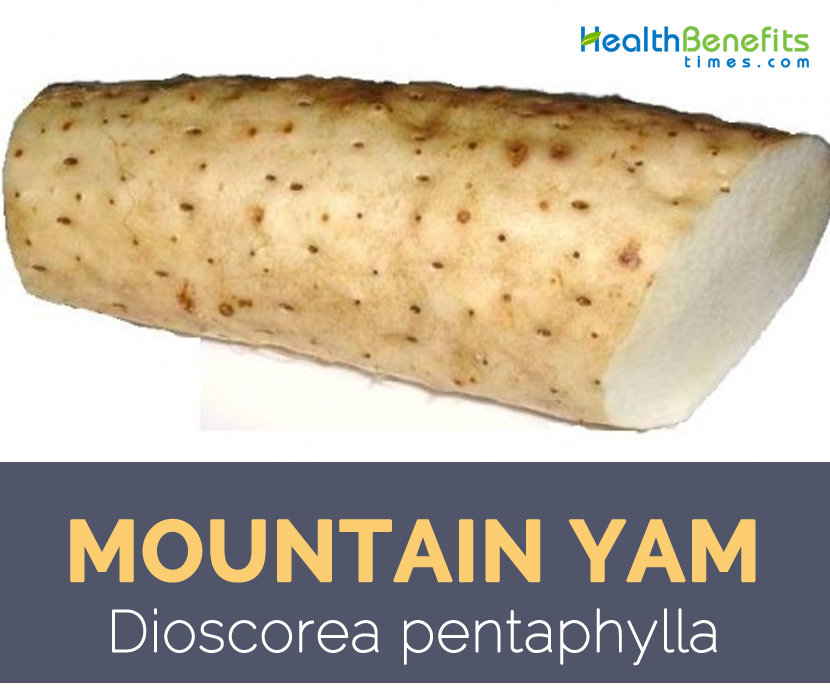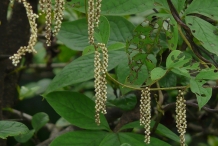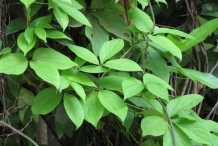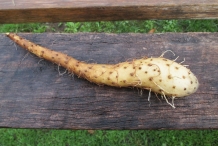Plant
Mountain Yam is herbaceous, climbing, twining, perennial monocots vegetables sized 30 feet (10 m) tall which grow well in lowland tropical areas. Normally it prefers a deep, well-drained, sandy loam that is not liable to water-logging. Stem is 2–5 mm in diameter, twining to the left, annual, terete, towards base woody and densely prickly, prickles lax on upper stem. Leaves are alternate and compound with 3 to 5 leaflets. Leaflets measure 2 to 4 inches (5-10 cm) long and 0.8 to 1.5 inches (2-4 cm) wide. Plant produces bulbils that are horseshoe shaped and about 1 cm in diameter. Male flowers occur in spikes up to 12 inches (30 cm) long at the branch ends whereas female flowers occur in spikes, but are shorter, 2 to 10 inches (5-25 cm) long. Flowering normally starts from August-October. Fruits are normally known as capsule that are black at maturity, long ellipsoid, and 2-2.5 cm, thinly leathery, sparsely hairy, wings 0.5–0.6 cm wide. Capsules consists of seeds that are 3–4.5 by 3.5–4 mm, lenticular-ovoid with a small apical projection; wing 7–11 by 3.5–5 mm, extending from seed base, oblong.
Tuber
The edible part of mountain yam is known as tuber that are usually single, irregular to elongated, egg-shaped portion of the plant. Tuber may weigh 3 pounds and may occur near the soil surface or more than 3 feet (1 m) underground. The tubers of the vine can be cooked and eaten. Tubers and bulbils are the edible parts, more commonly consumed in the north, commonly peeled and boiled or roasted.
History
Mountain Yam is native to southern and eastern Asia (China, India, Indochina, Indonesia, Philippines, etc.) as well as New Guinea and northern Australia. It is extensively grown as a food crop and naturalized in Cuba and on several island chains in the Pacific (including Hawaii).
Nutritional Value
Apart from their delightful tastes Mountain yam, cooked without salt is a good source of nutrients, vitamins and minerals. Consuming 100 gram of cooked mountain Yam offers 0.209 mg of Vitamin B6, 20 g of Carbohydrate, 0.129 mg of Copper, 0.283 mg of Manganese, 495 mg of Potassium and 0.48 mg of Vitamin B5. Moreover many Amino acids like 0.014 g of Tryptophan 0.061 g of Threonine 0.059 g of Isoleucine 0.109 g of Leucine and 0.067 g of Lysine are also found in 100 gram of cooked mountain yam.
Health benefits of Mountain Yam
Mountain Yam is a good source of Vitamins, minerals and nutrients that are essential to live healthy life. It is extremely beneficial in treating high blood pressure, fights diabetes, lower the risk of heart problems, helps maintain dental health and many more so including mountain yam in your daily diet is essential to solve all these problems rapidly.
1. Helps Treat High Blood Pressure
Several researches suggest that taking vitamin B6 supplements may be able to help lower blood pressure in people along with existing high blood pressure levels. Vitamin B6 present in mountain yam increases blood flow, lowers build up in the arteries and helps prevent common factors of heart disease. A cupful of mountain yam consists of 0.209 mg of vitamin B6 which is 16.08% of the recommended value.
2. Immunity
Copper found in mountain yam is a vital part of the healing process and ensures better wound healing. Copper acts as an extremely good immunity builder, and it also works as a cure for anemia, which will allow your body to both defend itself better and heal itself faster. Copper is a co-factor in numerous enzymatic processes that result in endothelial growth, or the healing process of tissue.
3. Fights and Damages Diabetes
Manganese is essential to help with proper production of digestive enzymes responsible for a process called gluconeogenesis. Gluconeogenesis includes the conversion of protein’s amino acids into sugar and the balance of sugar within the bloodstream. Though the exact mechanism still isn’t clear, manganese has been revealed to help prevent excessively high blood sugar levels that can contribute to diabetes.
4. Lower Risk of Heart Problems
Taking in an adequate quantity of potassium will put you at a lower risk of developing heart problems like stroke and heart disease. Mountain yam consists of 495 mg of potassium which is 10.53% of the daily recommended value. If you’ve already been identified with a heart problem, you’ve likely been told to watch your level of potassium.
Foods that are rich in potassium also consist of antioxidants as well as other minerals which will help your heart and result in greater overall healthiness. To complete your heart health profile be sure you’re receiving sufficient quantity of exercise each day, such as a walk, strength training, or yoga.
5. Healthy Skin and hair
Mountain Yam consists of considerable amount of Vitamin B5 which helps to keep skin healthy and attractive in appearance. It helps to delay the appearance of premature aging signs on the skin like wrinkles and age spots. Research has also revealed that Vitamin B5 plays an important role in the pigmentation of hair and prevents it from losing its color until you are well into your older years.
6. Improves brain function
It ensures smooth functioning of the brain and helps improve memory and concentration. Vitamin B1 found in mountain yam helps relieve stress and also helps strengthen the nerves. The vitamin is used to reduce the progression of multiple sclerosis, Alzheimer’s disease, cirrhosis, and other infections.
7. Helps Maintain Dental Health
Mountain Yam is a good source of phosphorus which is extremely important for bone health, it’s also important for maintaining teeth and gum health. Phosphorus along with Calcium, vitamin D plays an important role in the formation and maintenance of dental health simply by supporting tooth enamel, jaw-bone mineral density and holding the teeth in place thus, these minerals and vitamins can also help heal tooth decay.
Especially Children need foods high in phosphorus as well as calcium-rich foods while they are developing adult teeth in order to form teeth’s hard structure. Vitamin D is required along with phosphorus to regulate the body’s balance of calcium and improve its absorption during tooth formation. Vitamin D can also help to decrease inflammation of gums that is associated with periodontal gum disease.
8. Iron Deficiency Anemia
Cooked Mountain yam consists of 0.43 mg of iron which is 5.38% of the daily recommended value. Iron is helpful in the treatment of a severe disorder called iron deficiency anemia that results from a lack of iron in the human body. This is where most of these health benefits come from, as a result of preventing this terrible disease that affects millions of people around the world. It is one of the most common nutritional deficiencies on the earth.
9. Help Improve Muscle Mass
Consumption of protein is essential to build and maintain healthy muscle mass, while also supporting tendon, ligaments as well as other body tissue. When your diet is lacking amino acids, “muscle wasting” (or muscle atrophy) can take place when your muscle fibers are broken down to support your body’s energy needs.
Protein is particularly essential after exercise, since physical activity like strength training purposefully damages muscle tissues thus they can repair and grow back stronger. For the process to happen effectively, you need some extra protein to help repair the damage. While protein alone won’t enhance athletic performance, research shows that consuming protein before and after exercise will help increase muscle recovery, promotes muscle synthesis and serves as effective muscle ache treatment.
How to Eat
- Tubers and bulbils edible, more commonly eaten in the north, usually peeled and boiled or roasted.
Other Traditional benefits and uses of Mountain Yam
- Juice of the plant is applied to boils.
- A decoction of the plant is applied to swellings.
- A paste of the leaves made with mustard oil is rubbed into affected areas for the treatment of rheumatism.
- Tubers are tonic; used in swelling, rheumatism and as hair wash for killing lice.
References:
https://en.wikipedia.org/wiki/Dioscorea_pentaphylla
http://tropical.theferns.info/viewtropical.php?id=Dioscorea+pentaphylla
http://www.ebbd.info/dioscorea-pentaphylla.html
http://www.flowersofindia.net/catalog/slides/Five%20Leaf%20Yam.html
http://www.fs.fed.us/database/feis/plants/vine/diospp/all.html
Comments
comments
| Mountain Yam Quick Facts | |
|---|---|
| Name: | Mountain Yam |
| Scientific Name: | Dioscorea pentaphylla |
| Origin | Southern and eastern Asia |
| Colors | Light brown |
| Shapes | Single, irregular to elongated, egg-shaped tubers |
| Calories | 82 Kcal./cup |
| Major nutrients | Vitamin B6 (16.08%) Carbohydrate (15.38%) Copper (14.33%) Manganese (12.30%) Potassium (10.53%) |
| Health benefits | Help Improve Muscle Mass, Iron Deficiency Anemia, Helps Maintain Dental Health, Improves brain function, Healthy Skin and hair, Lower Risk of Heart Problems, Fights and Damages Diabetes, Immunity, Helps Treat High Blood Pressure |
| More facts about Mountain Yam | |



